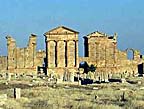 THE URBAN TRANSITION IN THE MAHGREB by Stephen Roskams, University of York
THE URBAN TRANSITION IN THE MAHGREB by Stephen Roskams, University of York
"Urban life was vital to Rome, so towns are a natural focus for those considering developments beyond the fourth century [in North Africa]. However, problems abound with the archaeological evidence for the p e r i o d . Practical obstacles are created by the diverse organisation of fieldwork in the different countries of North Africa, which limits comparability between regions.To this can be added the technical difficulty of defining tenuous stratigraphic distinctions in a dry climate. Additional methodological problems relate to the nature of post-Roman material culture. These include its complex sequences of buildings utilising diverse construction techniques; the later robbing of building stone dividing sequences into separate islands, with few diagnostic deposits to aid correlations between them; and the issue of finds residuality, since many artefacts were used for considerable lengths of time and then, at the end of their “normal” life, were either intentionally re-cycled as building material or simply redeposited when subsequent occupation churned up debris from earlier periods (for example, it is not uncommon for the vast majority of finds from provably post-Roman levels to be Roman in date). Finally, numismatic evidence rarely clarifies the dating of sequences as many coins are illegible and some areas produced no local coinage at particular points in time (for example the Carthage mint between AD420-80).
No comments:
Post a Comment